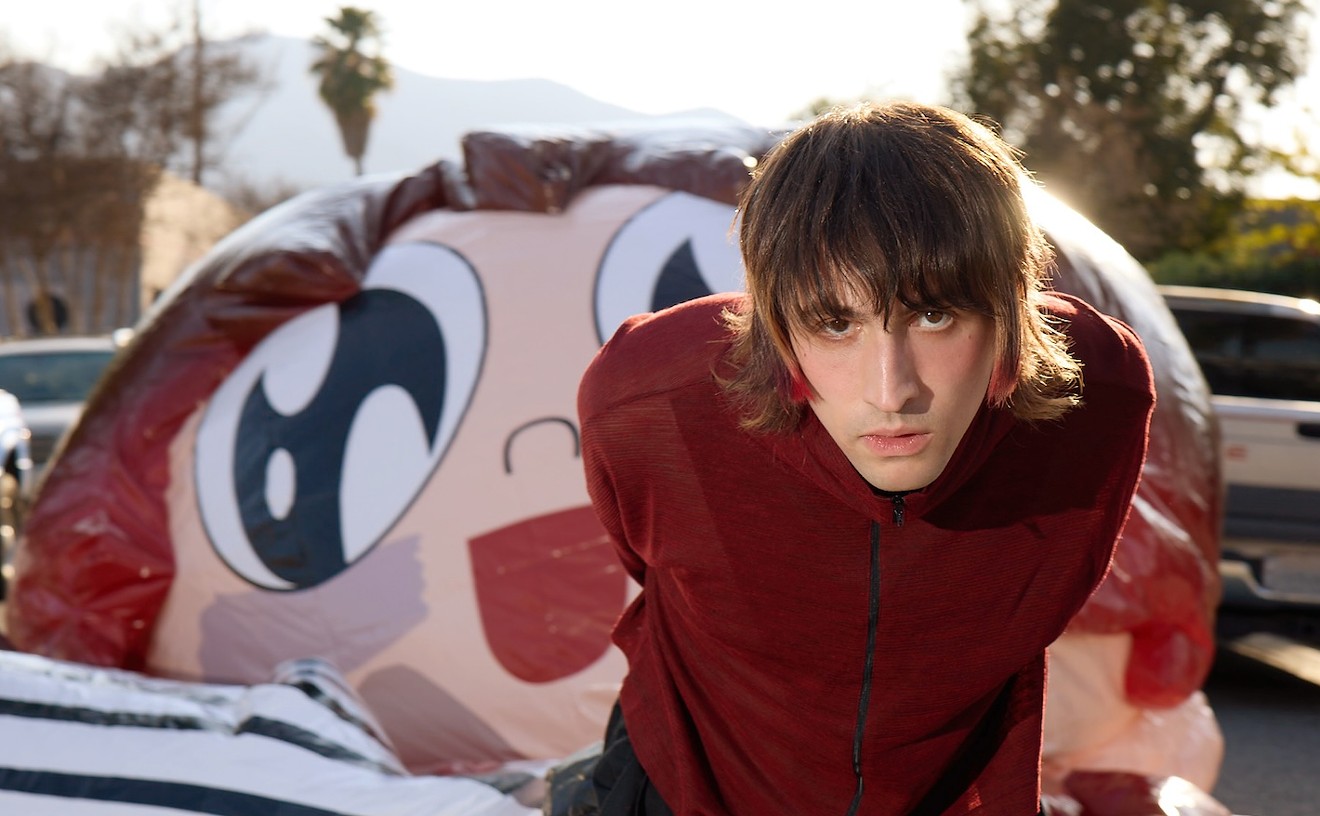When a b-boy battle gets going, it's like watching an exorcism. The trunk-rattling sounds of old-school hip-hop literally forced their way out of the speakers and into the bodies of each dancer, one at a time, for roughly fifteen minutes. Once they had been touched, they moved like they'd explode if they slowed down. A muscular guy in a white tank top nailed a headspin. The crowd shouted "BOOM!" The next dancer mimicked a fight move, pulling out an invisible gun and "shooting" his opponent in time with the beat. The crowd went nuts. If one of these guys could physically turn his head 360 degrees or levitate, surely this place would spontaneously combust.
A kid in a black knit cap jumped in and threw down footwork that almost burned a hole in the cardboard, ending in a freeze where the only thing touching the floor was his right forearm. A lanky guy on the other side mouthed a silent "oh shit" and unconsciously tried to copy the footwork before catching himself. It's so not cool to bite another dancer's move, but they watched each other intensely. And it was hard not to be mesmerized. The battle was a blur of all types of ill shit -- minute-plus headspins, backflips, Matrix-style freezes, and a guy sliding across the floor on his forehead. This was Floor Kings, a b-boy and MC competition put on by Fantum and Popcorn, two members of Broward's Unique Styles Crew.
The gym was a melting pot of young kids from Dade, Broward, and beyond -- Hispanic, African-American, Asian, Indian, white, male, female -- all there to show off their fifteen minutes of game. Mex, age 22, clad in baggy jeans and a studded belt, his dark curls plastered across his forehead with battle sweat, has been with Unique Styles Crew for two years. He has been breaking since he was seventeen.
"When I was seventeen, I could throw my body around," he said. "At my age, I have to stay away from the explosive moves, because my body won't allow me to keep doing them. Older b-boys beat younger b-boys because they stay clean, they're smooth. The younger b-boy thinks he has to flip three times in the air to make the crowd go wild."
To hear a 22-year-old say "at my age," you have to chuckle. But a b-boy constantly has to progress his moves, push his body into new positions. And that means injuries.
"I was paralyzed for a few seconds once," Mex said. "I decided to jump on my head, and I used my hands to push myself up. I did it and I couldn't feel my right hand or the right side of my body for twenty seconds. Then it went away. Our bodies do get banged up, but it's no different than playing soccer. [USC member] Felix messed up his knee, he just had surgery. Popcorn's elbow looks like, well, not an elbow. But for the most part, it's little injuries. We don't care, we'll still dance."
Breaking, which incorporates elements of jazz, tap, ballet, and martial arts, first emerged in the late Sixties. Its origins are twofold; part of it came from kids trying to copy James Brown's slick footwork, and it was used as an alternative to gang fighting. In 1969 hip-hop pioneer Afrika Bambaataa organized Bronx ghetto youth into the Zulu Kings, a group that would rather "dance than fight." This is where the faux fight moves came from, as rival gangs had to battle without physically touching. If you turned out a move your opponent couldn't top, you won. In the late Seventies, Rock Steady Crew, one of the more famous b-boy crews, added acrobatic moves like headspins to creative footwork.
Mex sees what his crew does as an extension of that old-school spirit. A b-boy, ideally, aims to combine footwork, style, creativity, and explosive power moves. Mex's style used to be more about the blow-up, the physical crowd-pleaser. But now he's trying to stay more conservative. "I'm starting to feel old because when a kid asks me to show him a move, I will," Mex said. "And then I see him doing it better than me. I constantly have to change my style, so when I'm thirty, I'll be beating b-boys who are seventeen, instead of in a wheelchair. I was the kid who went to clubs and sat at the bar because I didn't know how to dance. B-boying opened me up. My self-esteem definitely went up."
Indeed an integral part of b-boying is self-esteem, which in battles can come off as cockiness. "We're proud of being b-boys," Mex said. "Not just anyone can do this. Like an artist uses a brush to paint a canvas, we use our feet as brushes. You get people who say, öYou're wack,' and it's like, öNo, you are. Check yourself.' That's the tradition from back in the day. It's all in the way you carry yourself."
While Mex said USC collectively reps the 954, several members live in Dade and even as far away as Orlando. This distance allows for plenty of personal practice, which Mex said he does between five and seven times a week. "That's all you think about," he said. "You're in school, you want to practice. You're at work, you think about it."
The average age of the crew is nineteen, and it has twelve members: Mex, Non MS, Felix, Fantum, Groove Nom, Spee-D, Squid, Namek, Strider, Popcorn, Trigger, and Rival. Namek, Squid, and Trigger are the founders, and there were originally around ten to fifteen members. After a majority of the crew quit, there were five: Namek, Squid, Trigger, Felix, and Mex. Spee-D, who is from Orlando, joined in February of 2002. Then in June, twins Strider and Groove Nom joined (coincidentally, Namek and Squid are also twins). In January '03, Fantum joined, and later that summer Non MS added his popping and locking skills to the team. (Surely you know the "Robot" move made famous in the Eighties. If not, please go rent Breakin'.) Seventeen-year-old Popcorn is, naturally, also a popper, and regarded as one of the best in America.
With that many unique styles in one crew, you can imagine the pressure at a battle. "There used to be a lot of rivalry here, but it's getting better," Mex said. "The scene used to be rough, but the younger b-boys seem to just want to have fun -- no beef, no drama."
Mex cited the jams he's thrown across Florida, such as Outbreak and Civil Warz, as a source of the change in attitude and camaraderie among b-boys.
"I just do the jams to bring Florida together, and the younger crews decided to participate," he said. "I'm bringing people from out of state too."
USC has done some damage in and out of Florida. They won first place at Pro-Am in Miami, Breaklanta in Atlanta, and 3 the Hard Way in North Carolina, and placed at Spinfactor in Boston and B-boy City 10 in Texas. This weekend, Mex is putting on a jam called Yo! Pack It Up! The winners go to Rhode Island to represent Florida in the Spinfactor National Championship Finals.
The possibility of breaking becoming a mainstream commodity is very real; ESPN has started televising b-boy competitions, bringing local and national crews into the spotlight. Pop tartress Christina Aguilera featured b-boys in a recent video. Then there are urban dance movies like You Got Served, in which dancers battled with choreographed hip-hop video moves, taking out the grit and creativity of old-school breaking. Mex thinks the current state of hip-hop music is more to blame for that. "People think hip-hop is bling and spinners," he said. "In reality, it's not like that. It's about b-boying, graffiti, MCing, and DJing. I rarely listen to hip-hop -- unless it's the real stuff -- but I listen to the Cure, Radiohead, and Depeche Mode, too."
While USC continues to defy stereotypes, as well as gravity, Mex declared he's not nervous about breaking going mainstream. As long as there's a floor, he and his crew will be down.










